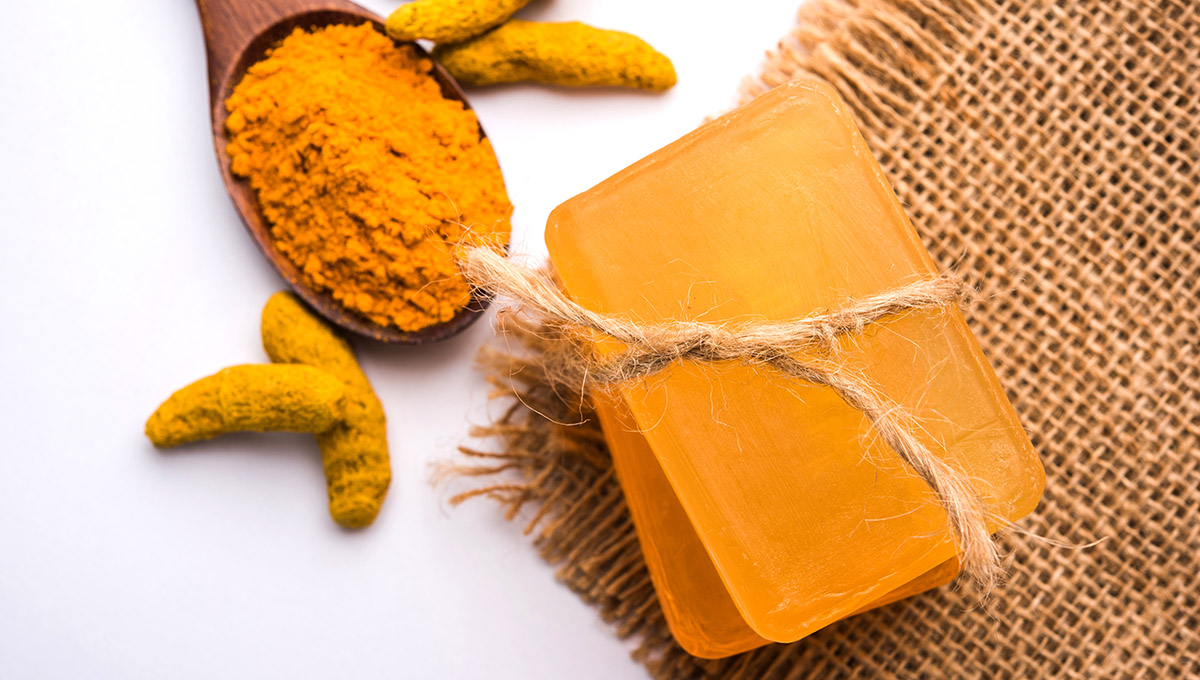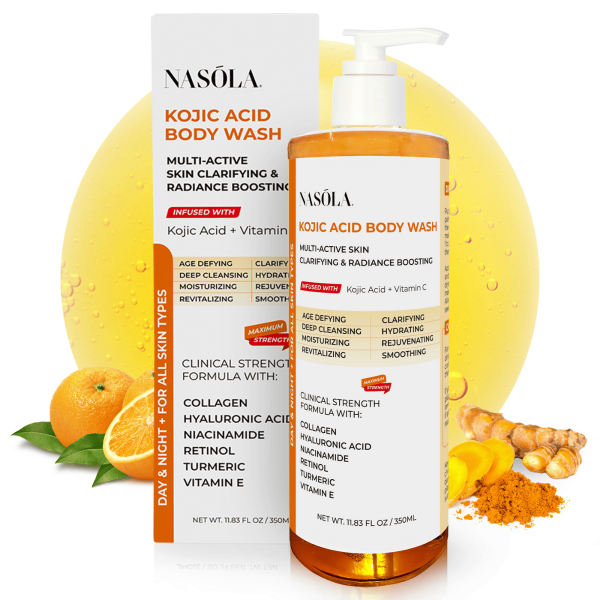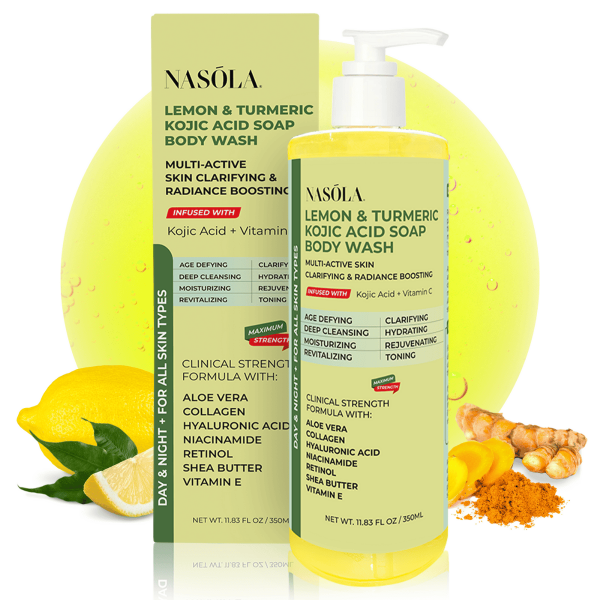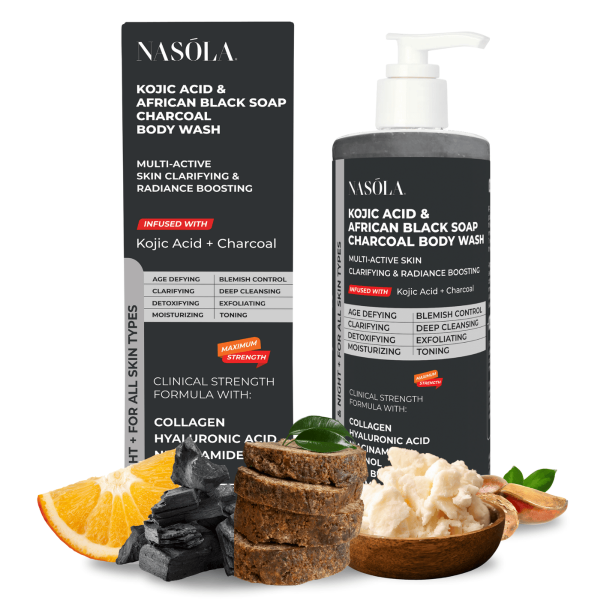Turmeric soap side effects are something most people don’t talk about—but they should. You hear all the buzz about turmeric brightening your skin, fighting acne, and fading dark spots, and YES, it does all that.
But what if you have sensitive skin… or eczema… or you just started using it and suddenly your cheeks are blazing red by lunchtime?
Not fun. And guess what? You’re not alone. That glow-up can turn into a flare-up if you don’t know what to expect ahead of time.
In this post, we’re covering everything—the good, the bad, and the breakout-y (yes, I said it). we’ll walk you through turmeric soap side effects, who should steer clear, and what safer, skin-loving alternatives you can try.
Oh, and we’ve got a few powerhouse product recommendations—like the vibrant Nasola Lemon Turmeric Kojic Soap & Body Wash and the mighty Nasola Kojic Acid Face Wash—that could be your glow-up BFFs without the drama.
Let’s get into it. I’m ready when you are…
- Understanding Turmeric Soap Side Effects: What You Need to Know
- Who Should Avoid Turmeric Soap
- Ingredient Spotlight: Kojic Acid as a Gentler Alternative
- Turmeric Soap Side Effects for Different Skin Types
- Alternatives to Turmeric Soap for Skin Brightening
- How to Minimize Turmeric Soap Side Effects
- Frequently Asked Questions
Understanding Turmeric Soap Side Effects: What You Need to Know
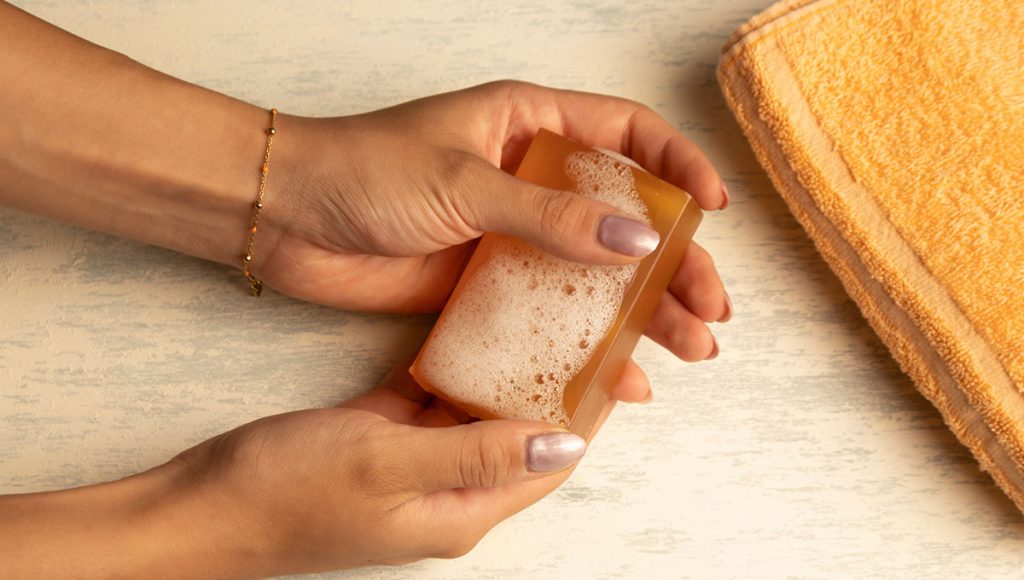
Turmeric’s been hyped as a miracle in a bar—skin-brightening, anti-inflammatory, acne-fighting brilliance. But too much of a good thing? Yeah, that can slap. The truth is, not everyone will react the same.
Turmeric soaps vary in concentration and formulation, and your skin type matters more than the aesthetic packaging it comes in. Understanding the possible side effects ahead of time can prevent a bad experience—and possibly an expensive regret.
Here’s the part many skip: being proactive. Performing a patch test? Monitoring for irritation? These steps could save your face. Knowledge is power, especially when it comes to what you’re putting on your skin daily.
Let’s take a closer look at what turmeric might do if your skin doesn’t vibe with it.
Common Skin Reactions from Turmeric Soap
When you slide that turmeric-rich bar across your skin for the first time, it can feel refreshing—until it doesn’t. Some people notice immediate skin reactions, which aren’t always dangerous but can be very uncomfortable.
Common turmeric soap side effects for unsuspecting skin:
- Redness or flushing, especially on the cheeks and neck
- Itchiness, sometimes with a warm or tingling sensation
- Dryness that makes your skin feel tight or flaky afterward
- Initial small breakouts or irritation bumps
These symptoms usually happen if the soap contains a high turmeric concentration or if your skin barrier is already compromised. It doesn’t mean turmeric is bad—it just might be bad FOR YOU… or in that form.
Don’t dismiss your skin’s reaction—listen to it. If it’s shouting, “Nooo!” believe it.
Allergic Reactions and Patch Testing
This part’s boring, I know—but crucial. Turmeric is a botanical ingredient, and just like pollen or peanuts, some people are allergic. 🤧 Yep, even in skincare.
Before lathering over your body, try a spot test behind your ear or on your forearm. Wait 24 hours. Look for signs:
- Swelling or significant redness
- Rashes or hives
- Burning sensation beyond mild tingling
- Increased dryness or skin peeling
If you experience any of those, STOP using it immediately.
Looking for something gentler? The Nasola Lemon Turmeric Kojic Soap & Body Wash is your answer. It blends turmeric with kojic acid and lemon extract—a combo that tackles dark spots and uneven tone minus the drama.
It’s a dream for those who want visible results without yellow stains or inflammation. Consider this your turmeric upgrade.
Who Should Avoid Turmeric Soap

Turmeric might be golden on Instagram, but let’s get real—not everyone should be sudsing up with it. Some skin profiles simply clash with turmeric products. That’s not a failure; that’s biology. (And no, you’re not doing skincare “wrong”).
If you fall under these categories, it doesn’t mean you can’t treat pigmentation or acne. It means there’s likely a better fit waiting for you (hello, kojic acid!).
Let’s spotlight who’s better off skipping turmeric altogether.
People With Sensitive or Reactive Skin
People with sensitive skin already deal with irritation from everything—fragrance, sun, even some face masks. Adding turmeric soap to that mix? Risky.
Turmeric has natural compounds like curcumin that benefit skin… but in sensitive individuals, those compounds can overdo it.
Watch for:
- Tingly sensation that turns into a sting
- Dry patches forming after use
- Skin that gets flaky within a few hours
- Skin that appears more flushed than usual
Don’t battle your skin every morning. Try giving it the TLC it deserves with alternatives formulated for sensitive users. Kojic acid is one option that still helps with pigmentation issues without triggering inflammation.
Individuals with Pre-Existing Skin Conditions
Rosacea, eczema, and psoriasis aren’t mellow conditions. They’re already inflammatory, and turmeric—despite its anti-inflammatory reputation—can overstimulate compromised skin barriers if used improperly.
If you have any of these:
- Rosacea (especially if your cheeks burn or flare easily)
- Eczema (turmeric could disrupt already dry skin layers)
- Psoriasis (it could cause flaking or additional patches)
Avoid traditional turmeric soaps. Instead, consider the gentler Nasola Kojic Acid Body Wash. It’s engineered to target dark spots and melasma with a calming formula that won’t spark a skin rebellion.
Ingredient Spotlight: Kojic Acid as a Gentler Alternative
Okay let’s pause for some real talk—turmeric isn’t the only skin-brightening MVP out there. Kojic acid? She’s the underdog queen. Derived from mushrooms during fermentation, kojic acid lightens hyperpigmentation and evens skin tone without the staining or aggression turmeric might bring.
If turmeric soap side effects have hit you hard or left you second-guessing, kojic acid might be your safer path to glow. Let’s break down why.
How Kojic Acid Works
Kojic acid isn’t just a trendy name. It works by suppressing melanin production in overactive areas—making it a weapon against those stubborn dark patches.
Why people love it:
- Fades dark spots and sun damage
- Helps with melasma and acne scarring
- Doesn’t stain your skin or clothes yellow (can I get an AMEN?)
- Compatible with daily skincare routines
Skip the harsh fade creams. The Nasola Kojic Acid Body Wash tones, brightens, and helps manage body acne—especially on areas like back and shoulders that are tough to treat.
Combining Kojic Acid with Other Soothing Ingredients
Pairing kojic acid with ingredients like African black soap, activated charcoal, or aloe? Unreal combo. This pairing does double duty: fade marks and calm your skin while cleansing deep.
Enter: Nasola Kojic Acid African Black Soap Charcoal Body Wash. It’s packed with:
- Detoxifying activated charcoal
- Smoothing black soap
- Brightening kojic acid
- Hydrating agents to reduce skin dryness
If turmeric stung, this will soothe. And if you’ve got oily or breakout-prone skin? This blend is like sending a gentle, hardworking cleaning crew straight to your pores—with zero drama.
Turmeric Soap Side Effects for Different Skin Types

Let’s get specific for a sec—because not all skin reacts the same. You might be dealing with flakes, while someone else breaks out. Knowing what turmeric soap side effects look like for your unique skin type helps prevent unnecessary frustration—or a soap-induced freakout.
Whether your skin leans dry or oily (or it simply can’t decide)… we’ve got you covered.
Dry Skin Types
Dry skin is thirsty, and turmeric soaps can sometimes strip natural oils even further—especially ones that contain high alkalinity or heavy turmeric concentration.
Watch for:
- Tightness, especially after rinsing
- Rough texture along the cheekbones or jawline
- Increased patchiness within 24 hours
- Flaking episodes that worsen over time
If you’re in the dry skin club, look for soaps or washes that combine turmeric with emollients or hydrating bases. Or consider skipping turmeric altogether and trying kojic acid in a deeply cleansing formula that doesn’t rob your face.
Oily and Acne-Prone Skin Types
Oily skin LOVES antiseptic ingredients like turmeric… at first. But if the formulation is too comedogenic or dense, it might clog your pores—leading to MORE of the breakouts you were trying to clear.
Key signs it’s not working out:
- Oil production spikes within 3 hours of use
- Breakouts in unusual places like temples or jawline
- Skin feels covered in residue
- Pores appear more congested
Instead of doubling down on raw turmeric, shift to the Nasola Kojic Acid African Black Soap Charcoal Body Wash. It handles oil and detoxifies without sending your skin into overdrive. Trust the science—and save your skin barrier.
Alternatives to Turmeric Soap for Skin Brightening
Alright. Here’s the glow-up plan, minus the hard lessons. Because avoiding turmeric doesn’t mean you’re skipping clear skin—it means you’re being smart. Bright skin, minimal fuss, zero orange residue? Yes, please.
Consider these dynamic duos and superstar blends instead:
Lemon Extract and Kojic Acid Combination
Lemon is a natural brightener, rich in vitamin C. Pair that with kojic acid and you’ve got a glow formula worthy of a shelfie.
Here’s why the combo works:
- Helps minimize sun-induced hyperpigmentation
- Accelerates exfoliation and cell turnover
- Boosts clarity without drying the skin excessively
- Pairs well with sunscreen and serums
Try the Nasola Lemon Turmeric Kojic Soap & Body Wash—it elegantly fuses turmeric in a gentler, better-behaved formulation alongside kojic and lemon extract so you still get the benefits… without the backlash.
Activated Charcoal and African Black Soap
For skin that’s all about the breakout life (and not in a fun way), this duo shines. Charcoal pulls impurities. Black soap smoothes texture. Add kojic acid and you’ve got the trifecta.
What they do:
- Deep purify pores
- Reduce body blemishes
- Brighten while preventing new dark spots
- Deliver softness you’ll keep touching
You guessed it—the Nasola Kojic Acid African Black Soap Charcoal Body Wash delivers major impact here without your skin turning tomato-red from irritation.
How to Minimize Turmeric Soap Side Effects
Still drawn to turmeric like a moth to a flame? I get it. If you absolutely want to make it work, there are ways to reduce the risks.
Managing turmeric soap side effects takes a combo of intention, patience, and support products.
Implement Patch Tests and Gradual Use
You don’t have to lather up your whole body on day one. Start slow. Monitor. Adjust.
Here’s how to ease it in:
- Start with every alternating day—even once a week
- Patch test first and WAIT 24 full hours
- Follow up with calming toner or moisturizer
- Rotate with kojic acid products to balance exposure
Skin is smarter than we think… but also moodier. Ease into anything new.
Use Moisturizers and Sunscreen After Application
Turmeric can increase photosensitivity. Meaning? Your clearer skin might burn more easily if exposed to sunlight.
Protect your progress:
- Wear SPF daily (yes, even indoors)
- Follow with a rich moisturizer, especially at night
- Reach for aloe vera or skin-calming masks post-use
- Support hydration from inside with omega-rich foods and water intake
Consistency—not intensity—is how clear skin wins.
Frequently Asked Questions
Not quite. While turmeric has amazing benefits for many, it’s not universally safe—especially for sensitive, dry, or reactive skin. Patch testing and moderation are essential. For a more balanced approach, consider alternatives like the Nasola Kojic Acid Face Wash or Body Wash that provide brightening effects without the irritation.
hat’s likely due to high levels of curcumin in the formula. Raw or concentrated turmeric can temporarily stain skin and fabrics. To avoid this, you can opt for a product like Nasola Lemon Turmeric Kojic Soap & Body Wash, which is specifically formulated to prevent staining.
Yes, it can—especially if it clogs your pores or disrupts your skin barrier. If you’re using one that feels greasy post-rinse or causes bumps, discontinue use and consider switching to a detoxifying and pore-safe option like Nasola Kojic Acid African Black Soap Charcoal Body Wash.
Kojic acid-based formulas work best for hyperpigmentation due to their melanin-inhibiting properties. Try the Nasola Kojic Acid Body Wash for body discoloration, or Nasola Kojic Acid Face Wash for facial dark spots or melasma.
This varies, but you may notice changes in 2–6 weeks. If you’re not seeing improvements—or you’re experiencing flare-ups—it’s time to re-evaluate and possibly introduce gentler alternatives like Nasola’s Lemon Turmeric Kojic Soap.
Only if it’s a gentle turmeric blend and your skin tolerates it well. For most people, daily use might cause dryness. Instead, alternate it with Nasola Kojic Acid Face Wash, which is designed for daily usage without compromising your barrier.
Sensitive skin often responds better to kojic acid formulations blended with calming agents. Nasola Kojic Acid Face Wash and Body Wash are excellent options that minimize irritation while still addressing brightening and acne concerns.
Yes. Dryness and peeling signal irritation or barrier damage. Immediately discontinue and switch to a fallback option like Nasola Kojic Acid Body Wash for safe and gradual brightening.
Some advanced formulations mix turmeric with ingredients that stabilize its effects—like lemon extract and kojic acid. Try Nasola Lemon Turmeric Kojic Soap & Body Wash for a cleaner experience without adverse effects.
Yes, it can. Eczema skin is extremely reactive. Turmeric may intensify redness or flaking in compromised barriers. Stick with gentle, hydrating alternatives like Nasola Kojic Acid Face Wash.
Subscribe To Our

